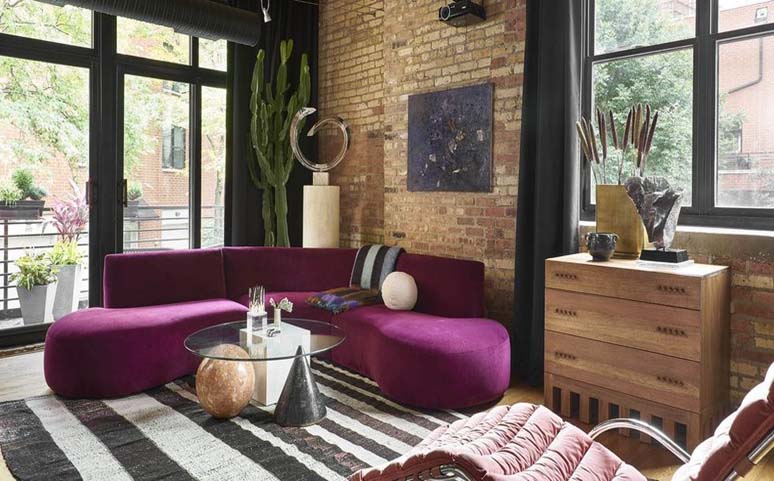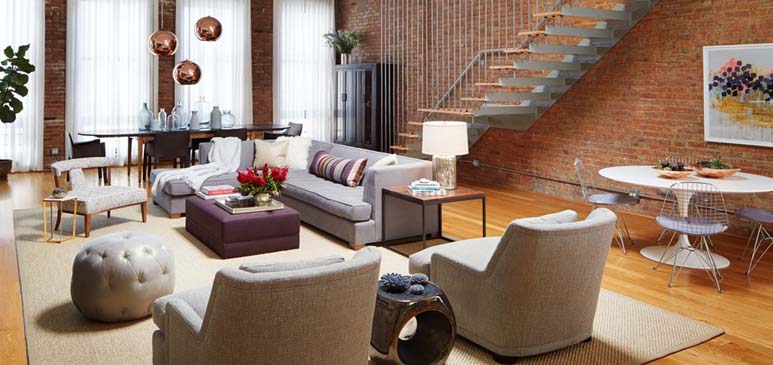Known for their raw materials, industrial interiors are often refurbished spaces with wood beams, concrete floors, exposed pipes, or brick walls. When working with an industrial-style design, it is important to create a balanced interior—one that is both reflective of its industrial history and one that feels livable and comfortable. A blend of colors, textures, and patterns can bring a warm and homey feel to an otherwise cool space, and oversized furnishings can add a level of comfort. Keep reading to discover nine ways to add warmth to industrial-style design.
MAKE SCALE TOP OF MIND
When designing an industrial space, scale is one of the most important considerations. Industrial spaces tend to be large and open, so it’s important that lighting, furnishings, and art reflect human scale. “One of the pitfalls people have is using pieces that are too small or disproportionate to each other to take advantage of breadth and height of an industrial space,” says Gilbert Melott, principal owner of Studio 6F.
To start, use large lighting fixtures, floor-to-ceiling drapery, and large area rugs, then layer in additional textures and fabrics. “Your furniture should feel in proportion to the space,” says Lauren Svenstrup, founder of Studio Sven. “I love using oversized curved sofas to tie large open plans together. Without the right pieces, the empty space can swallow the room and make it feel barren and cold. Ensuring the scale of every single piece of furniture is key in ensuring the space feels livable.”

USE LARGE-SCALE FURNISHINGS
As mentioned above, it’s essential that industrial spaces boast furnishings that reflect human scale. Because industrial spaces tend to be open concept, the right furnishings can help create boundaries within the space and ensure that the space does not feel cold or empty.
“Most industrial spaces have an open-concept floor plan, which can be intimidating when trying to figure out where to start," says Jennie Bishop, principal of Studio Gild. One of the biggest mistakes you can make when laying out an open-concept home is not taking the flow of traffic between spaces into consideration. Determine functionally conducive walkways between each space first, then lay out furniture so the flow of traffic is not compromised."
Use large-scale furnishings, such as large sectional sofas, tall freestanding shelving units, oversized cabinets and consoles, or long benches and daybeds to fill spacious areas. “Small-scale pieces get lost in large, open spaces, and they do not create the kind of boundaries necessary to craft gigantic loft spaces into intimate activity areas,” notes Jessica Lagrange of Jessica Lagrange Interiors.

DISPLAY OVERSIZED ARTWORK
Oversized artwork can help balance the scale of an industrial space, while also adding personality and warmth to the interior. “Art is a key component to adding that final touch of personalization to any space,” says Gretchen Murdock, founder and design director of MODTAGE Design. “It makes the space unique to the client and helps to create focal points to lead the eye. I always find that in looking at someone’s art, you are able to learn a little more about that person.”
“Smaller pieces of art can get lost on those large lofty walls,” adds Lagrange, who also uses framed pieces of wallpaper or textiles in place of large artwork.
ADD PERSONAL DETAILS
To create an industrial-style space that feels warm and livable, create a setting that feels intimate and personal to the homeowner—“either with curated vignettes or with heirloom and customized pieces that add an emotional connection to the environment,” says Melott.
Whether it’s with curated artwork, a personal library, or framed family photographs, use items that reflect the homeowners to give the space a warm and comforting touch. “Personal items that reflect the homeowner’s preferences allow the space to stand out as being uniquely appointed,” says Andrea Michaelson of Andrea Michaelson Design. “When using an industrial space that has industrial finishes as a background, you need to add more homey items to give it some soul and counterpoint.”
FIND THE RIGHT LIGHTING
When it comes to lighting an industrial space, think big and bold. “Little fixtures get lost in big, high-ceiling spaces, especially pendant fixtures which need to be bigger and bolder than what you would use in a residential space,” says Lagrange. “The same principles apply to floor and table lamps; they may need to be larger, more graphically bold and powerful than what would work in residential spaces.”
In the above image, designer Michele Plachter uses a hand-blown glass chandelier to create a focal point over the dining room table. “I am a huge believer that lighting is the jewelry in any space. The hand-blown glass globes we sourced are perforated so when the light is on, it reflects light patterns that sparkles at night and reflects off of the walls,” she says.
To create additional warmth, Bishop advises designers to use fixtures and bulbs with dimmers. “One of the biggest design elements that can be used to add warmth to a space is often the most overlooked one: lighting. Lighting types and how they affect the overall feel of a space is important. Use warm decorative lighting on dimmers and avoid cool LEDs or only recessed downlights,” she says.
EMBRACE TEXTURE
Pair rich and varied materials with raw and unrefined ones to ensure that an industrial space emits warmth and comfort. Use plush and colorful rugs, pillows, window treatments, and fabrics to contrast with the raw materials of an industrial space, thus taking the interior from cold to warm in an instant. "Things that are industrial are usually worn, dull, and large scale, so it’s important to bring in items that look polished to contrast with the industrial finishes,” says Michaelson.
Fabrics: When it comes to furnishings, experiment with rich and warm colors like reds, browns, pinks, and purples. Don’t be afraid to mix and match patterns and colors. Or, use neutral furnishings and layer them with patterned and colorful accents. “We often use neutral textiles with nubby or pile finishes on upholstery and add pattern and heavier duty texture with pillows, throws, and window treatments in lofts to respect their industrial edge,” says Lagrange.
Rugs: Area rugs are key, particularly in an industrial space where the floors may be made of concrete or distressed wood. Add color, texture, and pattern to any interior with a plush rug. “A large neutral sisal or wool rug can be used to establish a living area, and smaller, bolder area rugs can be layered on top of it to call out specific activity areas,” advises Lagrange.
Window Treatments: Lofts and other industrial spaces often have large windows. Add warmth to a space easily with floor-to-ceiling drapery. Lagrange says “sometimes it takes two layers to accomplish the look—a sheer layer and a heavier layer to maximize homeowners’ options.”
Pillows and Blankets: Throw pillows and blankets are an easy way to make a sofa, bed, or armchair feel cozy.
ADD POPS OF COLOR
The combination of colors and textures bring industrial spaces to life. “I am a firm believer that color can change the mood of any space. A pop of color against exposed brick? Yes please! Without the contrast of color, the space can look one-note and bleak,” says Svenstrup.
A bright yellow painting adorns the wall in a neutral living area to give the above interior—designed by Studio Gild—a pop of color. "Mixing in an acidic saffron, oversized 8-panel painting from Matt Mullican, gives vibrancy to the Milo Baughman masculine leather chairs," says Bishop.



















Your Message